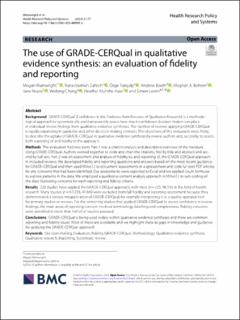| dc.contributor.author | Wainwright, Megan | |
| dc.contributor.author | Zahroh, Rana Islamiah | |
| dc.contributor.author | Tunçalp, Özge | |
| dc.contributor.author | Booth, Andrew | |
| dc.contributor.author | Bohren, Meghan A. | |
| dc.contributor.author | Noyes, Jane | |
| dc.contributor.author | Cheng, Weilong | |
| dc.contributor.author | Munthe-Kaas, Heather Eileen Menzies | |
| dc.contributor.author | Lewin, Simon Arnold | |
| dc.date.accessioned | 2023-09-25T10:54:56Z | |
| dc.date.available | 2023-09-25T10:54:56Z | |
| dc.date.created | 2023-08-30T14:21:25Z | |
| dc.date.issued | 2023 | |
| dc.identifier.citation | Health Research Policy and Systems. 2023, 21 (1), 1-15. | en_US |
| dc.identifier.issn | 1478-4505 | |
| dc.identifier.uri | https://hdl.handle.net/11250/3091727 | |
| dc.description.abstract | Background
GRADE-CERQual (Confidence in the Evidence from Reviews of Qualitative Research) is a methodological approach to systematically and transparently assess how much confidence decision makers can place in individual review findings from qualitative evidence syntheses. The number of reviews applying GRADE-CERQual is rapidly expanding in guideline and other decision-making contexts. The objectives of this evaluation were, firstly, to describe the uptake of GRADE-CERQual in qualitative evidence synthesis by review authors and, secondly, to assess both reporting of and fidelity to the approach.
Methods
The evaluation had two parts. Part 1 was a citation analysis and descriptive overview of the literature citing GRADE-CERQual. Authors worked together to code and chart the citations, first by title and abstract and second by full text. Part 2 was an assessment and analysis of fidelity to, and reporting of, the GRADE-CERQual approach in included reviews. We developed fidelity and reporting questions and answers based on the most recent guidance for GRADE-CERQual and then used NVivo12 to document assessments in a spreadsheet and code full-text PDF articles for any concerns that had been identified. Our assessments were exported to Excel and we applied count formulae to explore patterns in the data. We employed a qualitative content analysis approach in NVivo12 to sub-coding all the data illustrating concerns for each reporting and fidelity criteria.
Results
233 studies have applied the GRADE-CERQual approach, with most (n = 225, 96.5%) in the field of health research. Many studies (n = 97/233, 41.6%) were excluded from full fidelity and reporting assessment because they demonstrated a serious misapplication of GRADE-CERQual, for example interpreting it as a quality appraisal tool for primary studies or reviews. For the remaining studies that applied GRADE-CERQual to assess confidence in review findings, the main areas of reporting concern involved terminology, labelling and completeness. Fidelity concerns were identified in more than half of all studies assessed.
Conclusions
GRADE-CERQual is being used widely within qualitative evidence syntheses and there are common reporting and fidelity issues. Most of these are avoidable and we highlight these as gaps in knowledge and guidance for applying the GRADE-CERQual approach. | en_US |
| dc.language.iso | eng | en_US |
| dc.publisher | BMC | en_US |
| dc.rights | Navngivelse 4.0 Internasjonal | * |
| dc.rights.uri | http://creativecommons.org/licenses/by/4.0/deed.no | * |
| dc.title | The use of GRADE-CERQual in qualitative evidence synthesis: an evaluation of fidelity and reporting | en_US |
| dc.title.alternative | The use of GRADE-CERQual in qualitative evidence synthesis: an evaluation of fidelity and reporting | en_US |
| dc.type | Peer reviewed | en_US |
| dc.type | Journal article | en_US |
| dc.description.version | publishedVersion | en_US |
| dc.source.pagenumber | 1-15 | en_US |
| dc.source.volume | 21 | en_US |
| dc.source.journal | Health Research Policy and Systems | en_US |
| dc.source.issue | 1 | en_US |
| dc.identifier.doi | 10.1186/s12961-023-00999-3 | |
| dc.identifier.cristin | 2171036 | |
| cristin.ispublished | true | |
| cristin.fulltext | original | |
| cristin.qualitycode | 1 | |

